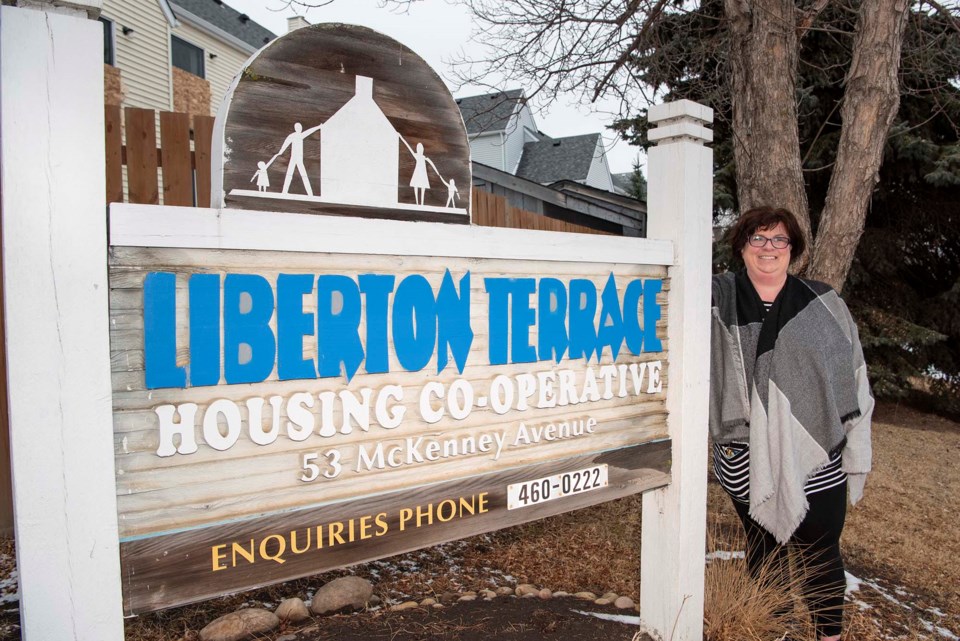Counting the cost
The Gazette is looking at how residents are dealing with the rising costs of living in St. Albert. If you have a question on why life is so expensive, email [email protected] so it can be answered in a future story.
There’s an affordable housing solution in St. Albert, and it has been on McKenney Ave. for almost 40 years.
Liberton Terrace is an easy-to-miss block of homes at 53 McKenney Ave. Whereas most Edmonton residents have seen double-digit jumps in their rents in recent years — 17 per cent last year, according to rentals.ca — Liberton Terrace residents have lived with one or two per cent hikes for years, said resident Chantelle Kiebiech. Recent years have seen rate hikes of up to four per cent to fund energy-saving renovations.
“One of our new members said that it feels like we’re living in million-dollar homes now!” Kiebiech said.
The co-op model
Kiebiech is president of the Liberton Terrace Housing Co-operative, which was established in 1986. The co-op is an example of non-market housing.
Non-market housing is housing meant for low and moderate-income groups not traditionally served by the private market. It’s often subsidized, and is typically operated by a government or non-profit.
A co-op is a member-owned, democratically operated organization that creates a business to gives back to its community. Co-ops can be used for many purposes, including housing, and can, as is the case with Liberton Terrace, operate as non-profits.
There are 129 housing co-ops representing 6,739 units in the Prairies, reports the Co-operative Housing Federation of Canada. St. Albert has about 93 of those units split between the Liberton Terrace and Heritage Hills co-ops, the Northern Alberta Co-operative Housing Association (NACHA) reports.
Housing co-op members collectively own their properties and elect a board of directors to manage them, said NACHA executive director Ayanna Inniss. Many co-ops get government funding to support low-income families.
Co-ops put a heavy emphasis on community involvement, said Kiebiech and Inniss. Liberton Terrace members hold regular potlucks, block parties, and cleanups, run a community garden, and encourage members to share their skills in teaching events.
“If you’re looking for a place where you can move in, close the blinds and just stay in the house, a co-op is not for you,” Inniss said.
Kiebiech said co-ops tend to attract a diverse range of ages and ethnicities. Many families live in them for multiple generations.
“Living in a co-op just becomes part of your life. It’s your home, and you have one big family.”
Cheaper…
Non-profit co-op homes are often cheaper than regular ones. A July 2022 study commissioned by the Co-op Housing Federation of Canada found co-op housing charges (rents) for apartments were about 25 per cent below market rates in 2006, rising to 33 per cent below by 2021.
Non-profit homes beat regular ones on affordability because they don’t have landlords looking to extract profit from them, said Margaret Kohn, a political science professor at the University of Toronto who studies non-profit housing. Most Canadian co-op homes have also paid off their mortgages by now, as they were built back in the 1970s-1990s when the federal government invested heavily in them, making them even more affordable.
Non-profit housing co-ops also offer more predictable rent increases than market homes, as members approve of any rate hikes in a vote and only raise rates to cover costs, Inniss said.
…if you can get it
If you’re looking to join a housing co-op in northern Alberta, good luck. There were 10 units available in NACHA’s service area as of April 8, three of which were in St. Albert. Kiebiech said there’s typically an eight-month wait to get into Liberton Terrace.
“Unfortunately, there have been very few new co-ops made in the last 30 years,” Kiebiech said, in most part because government funding for new co-ops basically stopped in the 1990s.
Housing co-ops are run by volunteers who don’t have the money or expertise needed to build loads of homes, Kohn said. While municipalities could help by creating land trusts for co-op housing, co-ops will need major financial support, likely from the federal government, to grow.
Inniss said the federal government’s 2022 commitment to put $1.5 billion toward housing co-ops should help, as soon as the money actually starts flowing. Kohn said the $1.5 billion Canada Rental Protection Fund announced earlier this month (which is part of the April 16 federal budget) could also help non-profits buy rental units and keep them affordable.
Kohn, Kiebiech, and Inniss said non-profit co-op housing could absolutely help solve Canada’s affordable housing crisis.
“There are projects that are ready to go,” Inniss said.
“We just need the money.”




